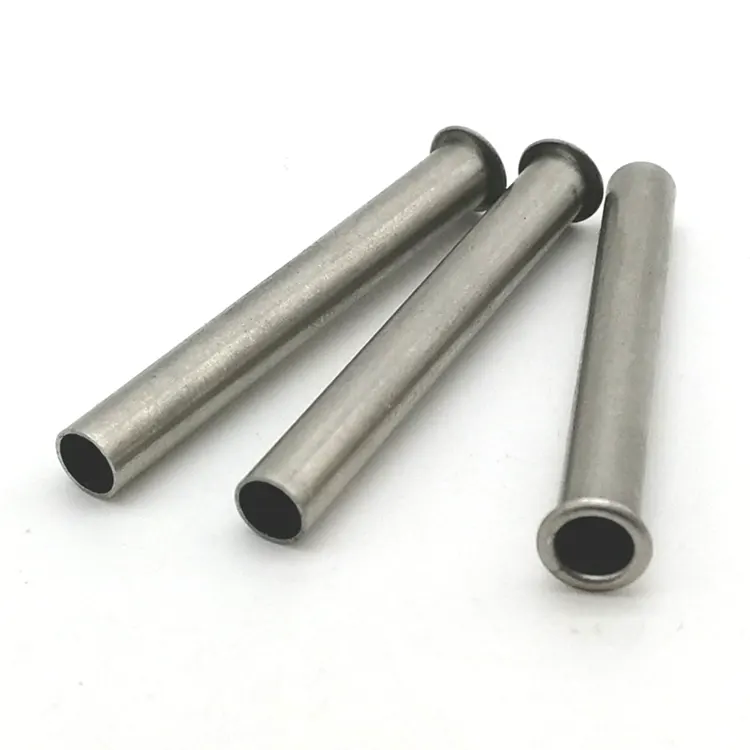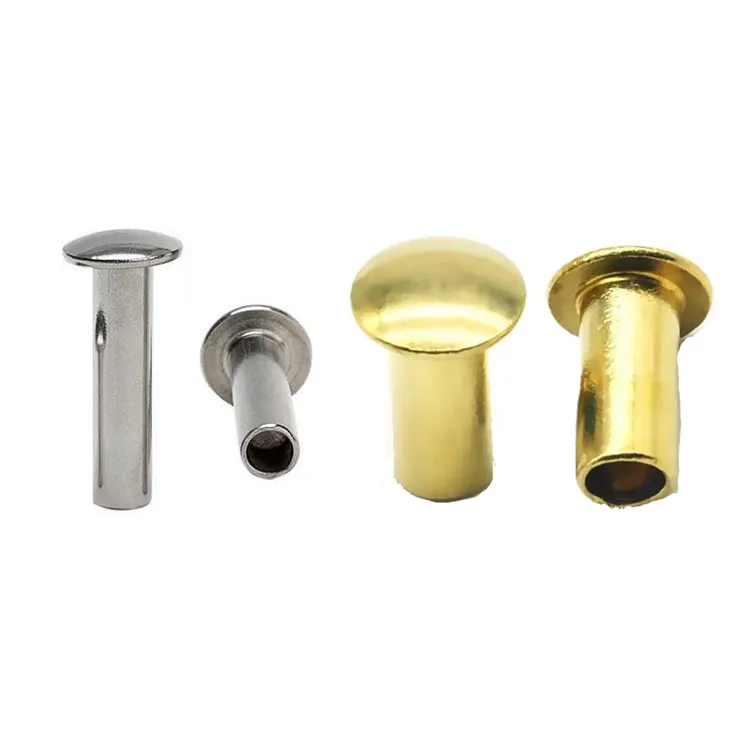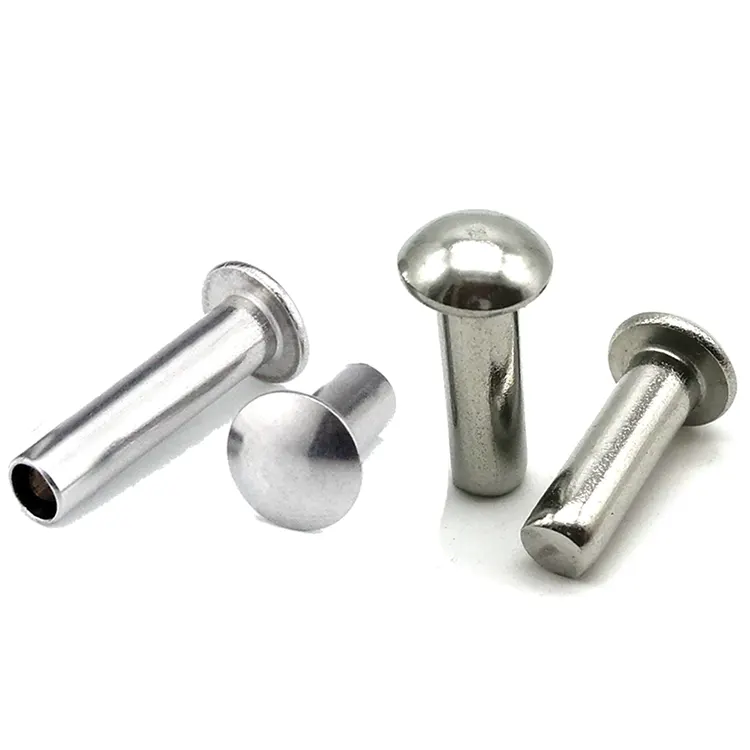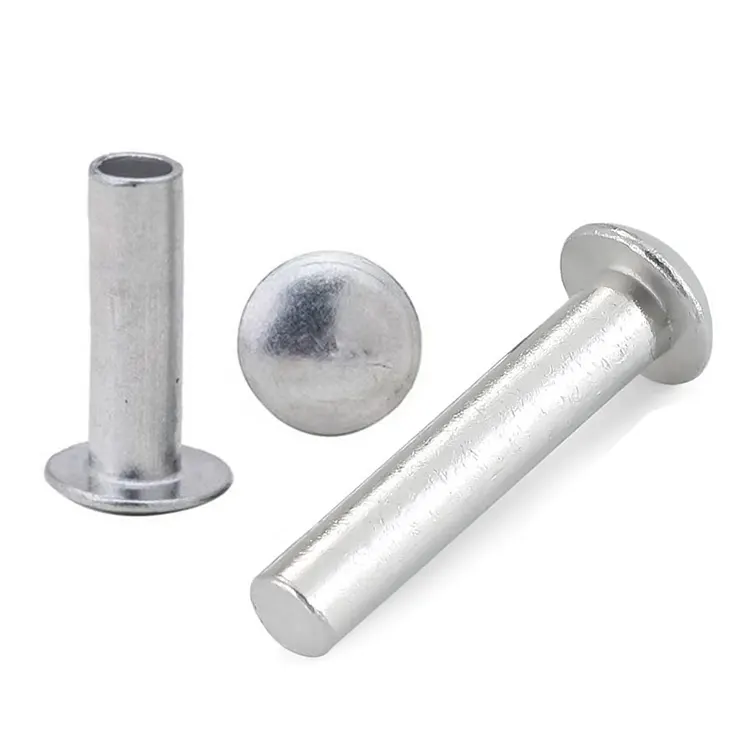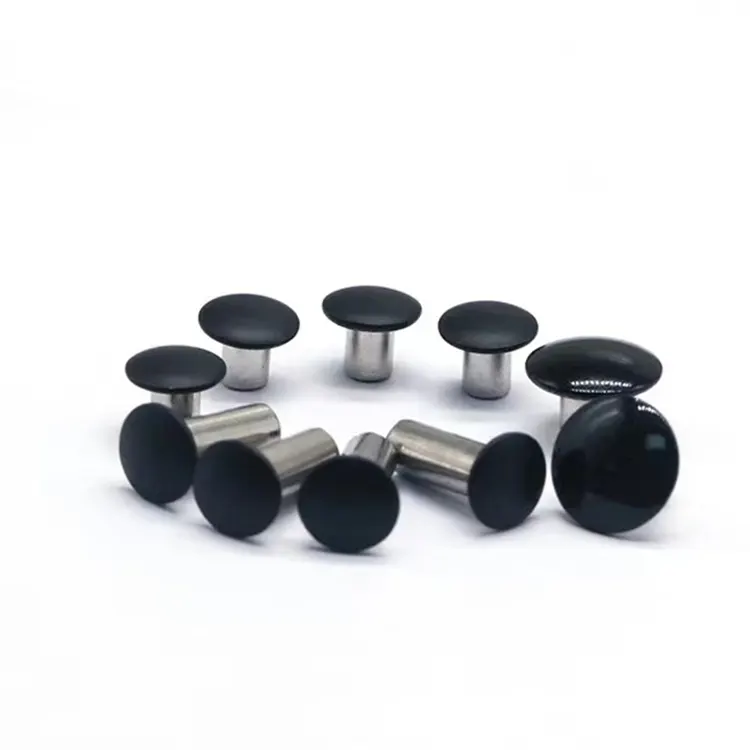Nieten
As one of professional manufacturer in China, Notin would like to provide you Rivets. And we will offer you the best after-sale service and timely delivery.
What is a rivet?
A rivet is a permanent mechanical fastener used to join two or more materials. Rivets work by inserting a metal pin into an aligned hole and deforming the end, creating a strong, secure, and durable connection. Unlike temporary fasteners like screws, rivets do not rely on threads, but instead form a permanent connection, making them ideal for applications requiring high strength, durability, and vibration resistance.
Classification of Rivets
Rivets are typically categorized by head shape, degree of hollowness, or material.
Based on head shape, rivets can be classified as flat head rivets, round head rivets, countersunk head rivets, mushroom head rivets, universal head rivets, truss head rivets, etc.

Based on degree of hollowness, rivets can be classified as solid rivets, semi-tubular rivets, or full tubular rivets.
Based on material, rivets can be classified as brass rivets, stainless steel rivets, steel rivets, aluminum rivets, copper rivets, etc.

What surface finishes are available for rivets?
Rivet surfaces are typically treated with rust-proofing treatments, primarily electroplating, including zinc plating, nickel plating, chrome plating, tin plating, gold plating, and silver plating. Electroplating is a common rust-proofing method for rivets. It applies a layer of plating to the rivet surface through physical or chemical methods. The plating effectively prevents corrosion and rust, while also providing a certain aesthetic effect.
Another special surface treatment method is head coating. Head coating is performed after the rivet is electroplated. This allows for a variety of colors on the rivet head, achieving an aesthetically pleasing finish.
Aluminum rivets cannot be electroplated, but they can be anodized. Anodizing also allows for a variety of color options, but the unit price is higher than electroplating.
Rust-proofing the rivet surface is crucial, effectively extending the rivet's service life and ensuring a secure connection. Different rust-proofing methods are suitable for different environments and applications, so the choice should be tailored to the specific situation.
- View as
Halbhohlnieten
Nuote Metals ist ein professioneller Nietenhersteller mit Sitz in Dongguan, China, einer industriell entwickelten Stadt mit bequemen Transportmöglichkeiten und einem umfassenden Angebot an Oberflächenbehandlungen. Halbhohlnieten sind ein häufig verwendetes Befestigungselement, das sich durch einen hohlen Abschnitt am Schaft auszeichnet. Durch diese Konstruktion können sie sich besser an die Verformung der verbundenen Materialien während des Nietvorgangs anpassen und so die Festigkeit und Zuverlässigkeit der Verbindung verbessern. Halbhohlnieten werden häufig in der Automobil-, Luftfahrt- und Schiffbauindustrie sowie bei der Montage von Elektronik- und Haushaltsgeräten eingesetzt.
WeiterlesenAnfrage absendenRundkopfnieten
Rundkopfnieten zeichnen sich durch ein einzigartiges Kopfdesign mit einem halbkreisförmigen Vorsprung aus. Diese Struktur verteilt die Spannungen bei Krafteinwirkung auf den Niet effektiv und erhöht so die Stabilität der Verbindung. Der erhöhte Kopf erleichtert außerdem die Positionierung und Ausrichtung während der Installation. Darüber hinaus bieten Rundkopfnieten eine hervorragende Korrosions- und Ermüdungsbeständigkeit und sorgen so für eine stabile Leistung über einen längeren Zeitraum in rauen Umgebungen. Suchen Sie nach Nieten aus China? Nehmen Sie einfach Kontakt zu Nuote Metals auf, wir verfügen über mehr als 10 Jahre Berufserfahrung im Bereich Nieten.
WeiterlesenAnfrage absendenPulverbeschichtete Nieten
Farbige Nieten, auch pulverbeschichtete Nieten genannt, werden durch einen Hochtemperatur-Spritzlackierprozess mit einer Pulverbeschichtung auf dem Nietenkopf beschichtet. Die Farbe wird gleichmäßig getrocknet, um ein lichtechtes Finish zu gewährleisten. Diese Art von Nieten erfordert ein hohes Maß an Geschick beim Einbrennlackieren und einer präzisen Farbabstimmung. Nach dem Nieten entsteht eine gleichmäßige und schöne Farbe, die ihre dekorative Wirkung voll entfaltet.
WeiterlesenAnfrage absendenFlachkopfnieten
Flachkopfnieten sind mechanische Bauteile, die zum Befestigen oder Verbinden von Metallmaterialien verwendet werden. Sie werden häufig in der industriellen Produktion, im Maschinenbau, bei der Autoreparatur und in anderen Bereichen eingesetzt. Die Funktion eines Niets besteht darin, das Nietrohr in die beiden zu verbindenden Metallteile einzuführen. Durch die Form des Nietkopfes und des Rohrstücks wird die Niete zusammengedrückt, wodurch eine dichte Verbindung entsteht. Nuote Metals ist auf die Herstellung von Flachkopfnieten spezialisiert. Wir verfügen über mehr als 40 Kaltstauchmaschinen und Tausende von Matrizen mit einer täglichen Produktionskapazität von bis zu 10 Millionen Nieten. Wir freuen uns über kundenspezifische Bestellungen basierend auf Ihren Zeichnungen und Mustern.
WeiterlesenAnfrage absendenBemalte Nieten
Lackierte Nieten mit lackiertem Kopf sind sehr korrosionsbeständig. Die Farbschicht, typischerweise 15–25 Mikrometer dick, isoliert sie wirksam vor Feuchtigkeit und Chemikalien. Salzsprühtests zeigen, dass lackierte Nieten über 500 Stunden lang rostbeständig sind, dreimal länger als unbeschichtete Nieten. Nuote Metals ist auf diese Art von Nieten spezialisiert und hat seinen Sitz in Dongguan, China.
WeiterlesenAnfrage absendenPilzkopfnieten
Der Name Pilzkopfniet kommt von seinem Aussehen und seinen strukturellen Eigenschaften. Ein Ende der Niete ist pilzförmig und relativ breit, was eine bessere Kompressionsfläche und einen ästhetischen Effekt bietet. Halbhohlförmige Nieten mit Pilzkopf haben am anderen Ende ein halbhohles Design. Beim Einbau wird mit einem Spezialwerkzeug der Hohlraum aufgeweitet, um eine sichere Verbindung herzustellen. Durch diese Konstruktion kann sich der Niet nach der Installation an unterschiedliche Materialstärken anpassen und gleichzeitig eine saubere und ästhetisch ansprechende Verbindung gewährleisten. Es sind auch massive Pilzkopfnieten erhältlich, die am hinteren Ende zu einem pilzförmigen Kopf verschraubt werden und so eine sowohl ästhetisch ansprechende als auch sichere Verbindung herstellen.
WeiterlesenAnfrage absendenWhat are the advantages of rivets over other fasteners?
1. Ease of Installation
Rivets are fast to install, and even fully automated for high-volume applications, resulting in a simple and efficient operation process.
2. Connection Reliability
The riveting process is standardized, with strict quality control, resulting in highly stable connections. Visual inspection allows for quick verification of connection quality.
3. Vibration and Impact Resistance
Rivets connect through deformation or interference fit, providing strong clamping force and excellent vibration resistance, capable of withstanding vibration and shock.
4. Low Cost
Rivets are easy to install and can be fully automated, saving significant labor costs.
What are the advantages and disadvantages of rivets made of different materials?
Aluminum Rivets
Advantages: Lightweight, reduces overall product weight, low cost, suitable for general civilian applications.
Disadvantages: Low tensile and shear strength, unsuitable for high-strength workpieces, prone to electrochemical corrosion when in contact with metals such as stainless steel.
Stainless Steel Rivets
Advantages: Strong corrosion resistance, high hardness, suitable for high-strength workpieces (such as marine equipment)
Disadvantages: Higher cost, typically more expensive than aluminum rivets of the same specification.
Brass and Copper Rivets
Advantages: Excellent conductivity (such as connecting electronic components), good corrosion resistance.
Disadvantages: Higher cost, more difficult to process.
Steel Rivets
Advantages: High hardness, high connection reliability, and wide applicability.
Disadvantages: Compared to other materials, iron rivets are more prone to rusting.
What are the main applications of rivets?
Rivets have a wide range of uses, from small items like a pair of scissors to large items like airplanes and ships, as well as in high-precision medical applications.
Industrial Manufacturing
Rivets are used in a wide variety of industrial fields, wherever there is a need to connect two or more materials.
Electronics
Rivets secure heat sinks and chips, providing both vibration damping and noise reduction, and are widely used in the cooling systems of electronic products such as computers and mobile phones.
Automotive
Rivets are widely used to connect components of automobile bodies and chassis, such as doors and hoods. Their lightweight and corrosion-resistant properties make them an indispensable joining method in automotive manufacturing.
Aerospace
In aircraft manufacturing, rivets are used to connect different fuselage components, such as wings and tailplanes. Millions of rivets create high-strength, corrosion-resistant joints. Aluminum and titanium alloy rivets are often used to connect components of corresponding materials, ensuring stability in extreme environments.
Rivets are used everywhere. The above examples only represent a small number of their applications. We see rivets everywhere in our daily lives, such as on scissors, folding beds, and strollers etc. Rivets can be customized to different sizes and materials depending on the application.
Nuote Metals has specialized in the rivet industry for over a decade. Our factory is located in Dongguan, a city known as the "World Factory," a city with a developed industry and convenient transportation. This allows us to respond quickly when acquiring raw materials and supporting surface treatments, meeting our customers' needs for quick access to samples and bulk orders. We produce 10 million rivets daily and have molds of various specifications, allowing us to produce rivets as small as 0.8mm and as large as 10mm. We welcome your inquiries and visits.


